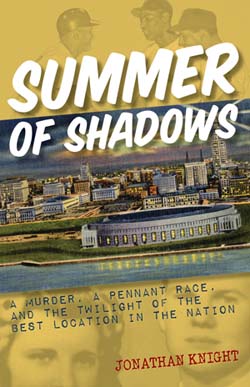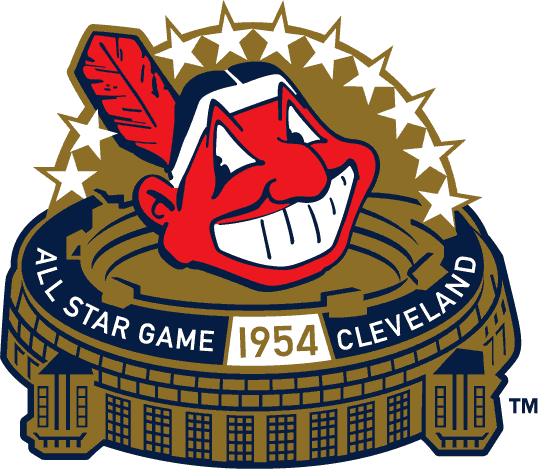 Indians Archive
Indians Archive  Summer of Shadows Excerpt: The All-Star Game Comes to Cleveland
Summer of Shadows Excerpt: The All-Star Game Comes to Cleveland
 The following is an excerpt from Summer of Shadows: A Murder, a Pennant Race, and the Twilight of the Best Location in the Nation by Jonathan Knight:
The following is an excerpt from Summer of Shadows: A Murder, a Pennant Race, and the Twilight of the Best Location in the Nation by Jonathan Knight:
Starting that Monday, for three days, Cleveland was the center of the baseball universe.
By car, bus, train, and plane, fans poured into the city from all over Ohio as well as neighboring states. Those who arrived without hotel reservations were in for an inconvenient stay. All downtown hotels had been booked for a month, sending some visitors scurrying out of town to secure accommodations.
Even those who didn’t make the trip could enjoy one of the great annual spectacles of an American summer. The Mutual Broadcasting System would deliver the game across 560 radio stations, while Gillette sponsored NBC’s national telecast.
Better than 68,000 fans would pack into the ballpark on the lake on this Tuesday afternoon, slightly short of expectations that called for a crowd of better than 70,000, which would have set a new All-Star Game attendance record.
As it happened, the mark of 69,812 from the first time Municipal Stadium hosted the event in 1935 was still number one and would remain atop the list for another twenty-seven years—until the third time Cleveland hosted the All-Star Game.
Hank Greenberg welcomed the entourage of reporters and baseball dignitaries like a proud father at his daughter’s wedding reception. After years of struggle and being second-guessed as GM, Greenberg and his decisions had been verified by the Indians’ strong first half. Now he hoped to continue the trend. Fueled by newfound confidence, he pointed to the mammoth crowd as proof that his radical interleague play concept could work. “I proposed it because I think it’s good for baseball,” he said. “If it’s turned down, I won’t be distressed—it’s experimental. It may work, it may not. But we won’t know unless we try.”
A full-page ad in that week’s Sporting News depicted a cartoon of Chief Wahoo standing outside Municipal Stadium holding a key to the city. “Your 1954 All-Star Host, the Cleveland Indians,” the headline declared. The text below shifted into Hollywood “Indian” diction: “Heap Big Welcome to Honored Players—Distinguished Officials—Loyal Fans.” Included among these loyal fans were thousands of Tribe rooters who saw this three-day festival as an appetizer for later delicacies. “No doubt many of them considered the big day a forerunner of others to come—in October,” The Sporting News conjectured. “The Indians passed the traditional July 4 milestone in first place. Pennant fever once again beads the brows of Uncle Moses’ children.”
Northeast Ohio fans were also eager to get a first-hand look at the almost-mythical players from the far-off land of the National League. Likewise, many National League All-Stars, including Stan Musial of St. Louis, would get their first look at iconic Municipal Stadium.
In an interview just after arriving in Cleveland on Monday, the Giants’ Willie Mays insisted that he knew all about Municipal Stadium and was looking forward to seeing what he could do with the short right field and tall right field wall. The reporter looked at Mays questioningly. Brooklyn catcher Roy Campanella overheard the comment and burst out laughing. “Not that park!” he cried. “This is the big stadium down by the lake, the biggest baseball park in the country.” The Say Hey Kid had been thinking of the Indians’ old home, League Park, which they’d abandoned a good eight years before and Mays had encountered during his brief tenure in the Negro Leagues. “You could put League Park inside the stadium!” Campanella pointed out.
Any other time of year, the image of a Giant and a Dodger not only joking side-by-side but preparing to join forces would seem utterly displaced. Each July, the All-Star Game served as a peaceful armistice, a welcome three-day interruption to often-heated pennant races. Rivals became teammates and their objectives became much broader. Just as the ten participating Giants and Dodgers temporarily forgot their disdain for each other’s ballclubs, the nine Indians and Yankees could put aside their partisanship and focus on underlining their league as the superior circuit.
Yet for all the good-natured ribbing and congenial reunions, there was also a detectable level of tension. Some players appearing for the first time were apprehensive about making fools of themselves on such a grand stage. Though Al Rosen had played in the previous two All-Star Games, he became more and more uneasy as Tuesday approached.
On Sunday, as the Indians finished their disastrous trip to Chicago, he asked Al Lopez to call Casey Stengel on his behalf. Though he would undergo x-rays on Monday and would learn that the finger was healing nicely, Rosen’s grip on the bat, and consequently his swing, was still compromised. He wasn’t afraid he would worsen the injury by playing in the All-Star Game but that he would hurt the American League’s chances for victory. He, like the players and managers on both sides, wanted very badly to win.
In the years to come, the All-Star Game (and all subsequent versions in other sports) would serve as little more than a showcase for individual achievement. The outcome of the “game” itself matters little, if at all. But in 1954, as in the twenty All-Star Games that came before it, the Midsummer Classic was a serious competition, a prime opportunity for each league to prove it was better than the other. Casey Stengel selected his players not to fulfill quotas or massage egos but to construct a team capable of winning. Though he’d won five World Series, Stengel had failed in four attempts to captain the American League to victory in an All-Star Game. And he wanted very badly to do so.
Lopez eased Rosen’s concerns but didn’t relay the message to Stengel, who didn’t learn about Rosen’s hesitancy until he told the manager just before the game. After getting little sleep on Monday night, Rosen awoke Tuesday morning with a finger throbbing worse than ever. “I probably won’t do your club any good,” Rosen explained, “because I haven’t helped my own club lately.”
True enough, Rosen’s batting average had dropped sixty points since he’d injured his finger in May, and he’d only hit one home run in the previous six weeks. Stengel respected his intentions, but thought even an injured Rosen could help the team. Plus, all starters were required to play at least the first three innings. After discussing the matter with baseball commissioner Ford Frick and receiving permission, the wily manager made a deal. Bat once, he said, and if Rosen wanted him to take him out of the game, he would.
The tone for the afternoon was set before the first pitch, when the world-renowned Cleveland Orchestra presented a one-hour concert. As music echoed through the park on a sunny summer afternoon, the temperature continued to climb. The drought that had parched the city entered its second month. At game time, thermometers outside of Cleveland swelled to 93 degrees, though the steady lake breeze coursing through the stadium kept it much more tolerable, hovering in the low eighties. All downtown streets leading to the ballpark were jammed by noon, ninety minutes before game time. Air traffic swarmed around Burke Lakefront Airport, with private planes landing by the minute carrying passengers heading for the game.
Whitey Ford, the American League’s starting pitcher, cruised through the top of the first, but after Minnie Minoso flied out to open the bottom of the frame, Bobby Avila gave the hometown crowd something to cheer about by lacing a single to left off Philadelphia’s Robin Roberts. Mickey Mantle flied out and Yogi Berra walked, moving Avila into scoring position.
With a chance to further energize the crowd by bringing his teammate home and giving his team the lead, Al Rosen struck out to end the inning. If he’d been retired any other way, Rosen likely would have taken himself out of the lineup. But striking out in front of a huge crowd in his own ballpark ignited Rosen’s pride. For the first time in weeks, he forgot about his aching finger. When Stengel approached him, he said he wanted to stay in the game.
When Rosen returned to the dugout after the National League batted in the second inning, Boston great Ted Williams slid over on the bench beside him and started talking about what had happened in Rosen’s first at-bat. When you’re facing a pitcher you don’t think you can get the bat around quickly enough against, Williams said, make sure you choke up on the bat. He illustrated his point with a nearby bat and, through the remainder of the inning, he and Rosen discussed how to improve his swing.
With the game still scoreless in the third, the American League threatened once again with a leadoff walk to Minoso and another single by Avila. But Mickey Mantle was retired and Berra grounded out to advance the runners. Just as he had two innings before, Al Rosen stepped to the plate with two on and two out. But this time, choking up on the bat ever so slightly and lifting his mangled right index finger off the handle, he crushed a Roberts pitch over the outfield wall in left center field for a three-run home run. The colossal crowd howled in delight. After crossing home plate, Rosen was swarmed by his teammates in the dugout, including Williams.
After the Tigers’ Ray Boone followed with another home run seconds later, the AL led 4–0 and appeared poised to coast to victory. But in the fourth, Stengel replaced Whitey Ford with Chicago’s Sandy Consuegra, who was promptly bombed for five hits and five runs to put the National League on top. The Municipal Stadium throng roared again when Stengel called on Bob Lemon, who cleaned up the mess and got out of the inning. Despite Lemon’s effectiveness, one of the great slugfests in All-Star Game history had begun.
Summer of Shadows is now available at amazon.com and bookstores everywhere.
- NBA Announces 2013-2014 Schedule
- Browns Ink Sharknado
- Sharknado A No-Show For Rookie Camp
- Trent Richardson Out Until Training Camp
- Browns Sign Brandon Jackson
- Carrasco Suspended Eight Games
- Browns Add to Wide Receiver Depth with David Nelson
- Browns Need to Learn from Past Draft Mistakes
- Browns Release Chris Gocong and Usama Young
- Browns Missing on Grimes Disappointing, But Not The End
The TCF Forums
- Chris Grant's first 3 drafts
Kingpin74 (Tuesday, January 21 2014 10:13 AM) - The 2014 Offseason Thread
googleeph2 (Tuesday, January 21 2014 9:36 AM) - 2015 Recruiting
furls (Tuesday, January 21 2014 6:57 AM) - Mike Brown
YahooFanChicago (Monday, January 20 2014 11:15 PM) - Movies coming out
HoodooMan (Monday, January 20 2014 9:34 PM) - 2014 Hoops Hockey Hijinx
jpd1224 (Monday, January 20 2014 4:44 PM) - 2014 Recruiting
jclvd_23 (Monday, January 20 2014 2:26 PM) - Wish List - #4 Pick
Hikohadon (Monday, January 20 2014 1:26 PM) - Official- Browns Coach Search/Rumors
OldDawg (Sunday, January 19 2014 6:48 PM) - #1 overall pick Anthony Bennett
TouchEmAllTime (Sunday, January 19 2014 1:28 PM)



